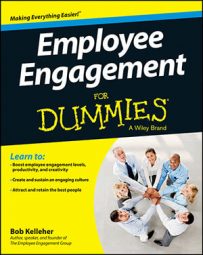Unfortunately, employee disengagement is much too prevalent. Since the Great Recession of 2008–2009, a “perfect storm” of company layoffs, marginal opportunities, minimal pay increases and bonuses, limited opportunities for promotion, and reduced training and development has resulted in rising levels of disengagement.
Do you have disengaged employees?
According to a 2012 Dale Carnegie white paper, “What Drives Employee Engagement and Why It Matters,” 45 percent of employees are only partially engaged, and a horrifying 26 percent are disengaged! This lack of engagement is costing companies billions of dollars in lost productivity and reduced levels of client service, resulting in declining profits and worsening client satisfaction.
In boom times, disengaged employees simply seek other opportunities. But in a recession, the disengaged have no place to go. They hunker down, fearful for their jobs.
Although management may view the current economic circumstances as helping to separate the wheat from the chaff, rationalizing that the people who stay are the truly dedicated employees, this may not be the case. These people may well just be the employees who are the most disengaged.
To exacerbate matters, many people are postponing retirement to give their 401(k) plans and other retirement funds a chance to rebound. The result? A workforce composed of employees who don't want to be there and retirees hanging around for “one more year.”
In a situation like this, it becomes even more urgent to increase employee engagement — and perhaps even more important, to capture the discretionary effort of the engaged before their frustration with their disengaged colleagues’ apathy takes a further toll on the workplace and the economy at large.
Don't be afraid to prune. In fact, given the strong link between poor performance and disengagement, a good place to start may be the aforementioned staff who are disengaged but staying put!
The economy and disengaged employees
Things won't get easier with a turn in the economy. Indeed, they could get harder, as employees take advantage of the rising tide and, well, jump ship. Indeed, there is a real threat that many businesses will soon be faced with a staff exodus, and the waste — in training and intellectual capital, but also in revenue — will be colossal.
The war for talent will officially resume. And when it does, those companies that have continued to engage employees during the downturn will have a distinct advantage.
Turnover affects employee engagement
So, what does it matter if turnover is high? Well, at the most basic level, employee turnover is expensive. According to some industry sources, the cost of turnover is, on average, the annual salary of the person being replaced — or significantly higher (think 200 percent to 250 percent) if the employee who exits is part of your managerial or sales team.
It's not just running ads and/or commissioning a recruiter that empties company coffers; the more difficult and more expensive outlay involves the loss of productivity while the empty position is unfilled.
And that's not even counting the intellectual property that the person who leaves takes with her or the waste of the financial investment a company has made in that person, not to mention the very real likelihood of the employee leaving your business to join your competitor.
The damage doesn't stop there, however. Turnover has a Pied Piper effect. As people walk, others talk. They wonder, “Why did Jamie quit?” Even if an employee is leaving on the best possible terms, those who stay are bound to ask themselves, “What did Jamie know that I don't? Should I be looking around, too?”
And if the terms of the parting of ways are less than ideal, or if people are quitting in droves, the impact on morale is even more detrimental. Even the sunniest internal communications spin on the situation can't entirely eradicate gossip, speculation, and skepticism.
Not all turnover is created equal. In fact, losing your underperformers will strengthen your business. When disengaged employees or those who are known underperformers leave, you'll almost always experience a spike in engagement from remaining, hard-working employees.
Companies that “get” engagement understand that to engage their top performers, they must prune their underperforming employees and address their disengaged employees.
Enlightened companies track voluntary turnover (employees who quit, often to seek opportunities elsewhere) and involuntary turnover (layoffs, termination due to poor performance, and temporary employees, such as interns, who leave because their assignments have ended).
Some companies also track “key” employee turnover. Losing a superstar is significantly more painful than losing a “steady Eddie” employee. Identifying your top performers and tracking their turnover is a must for any company looking to build a high-performing business.

